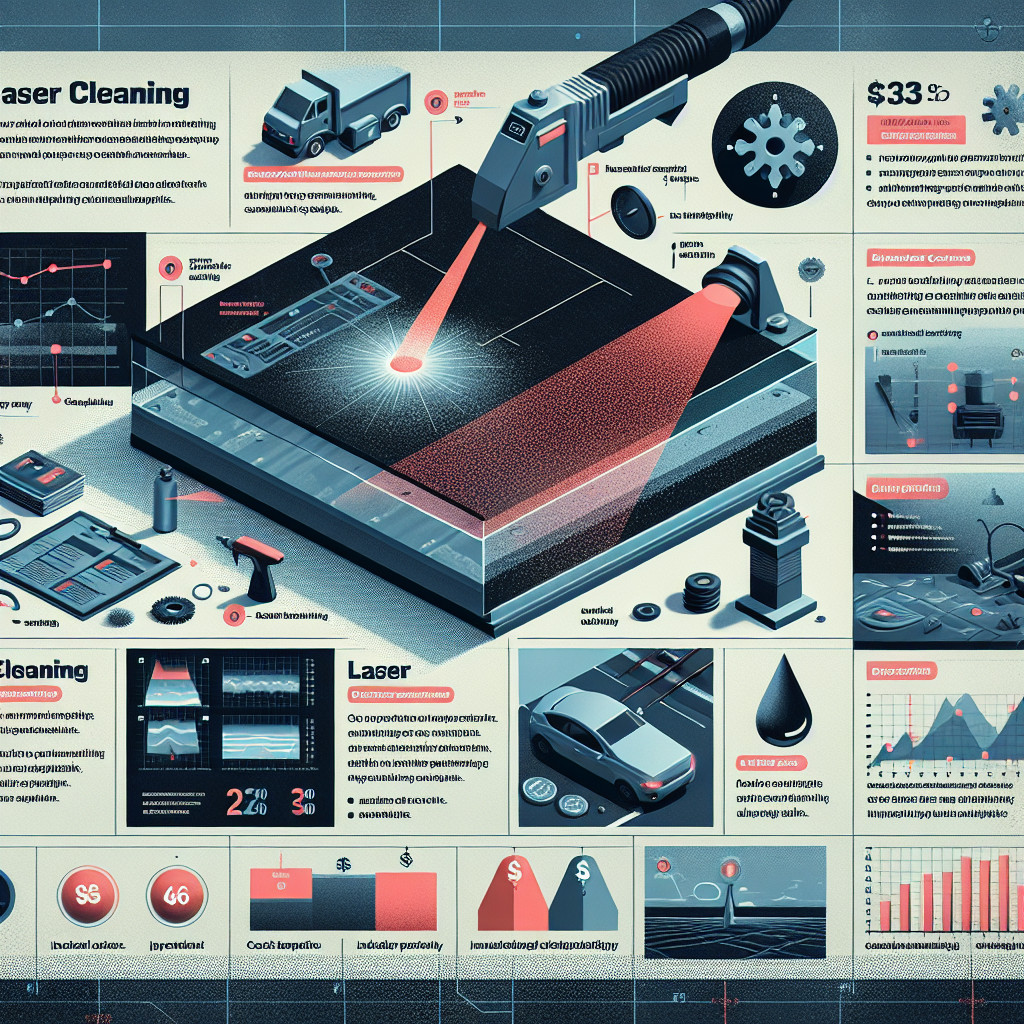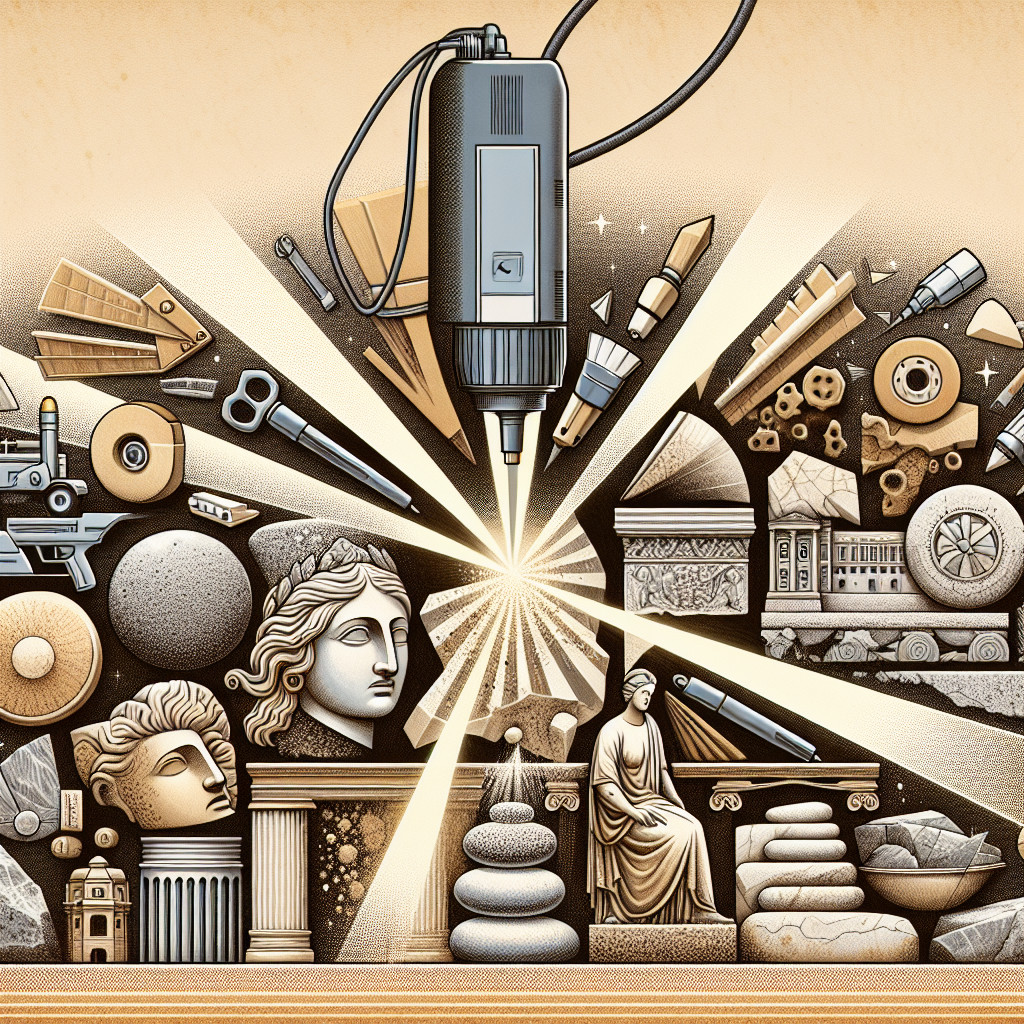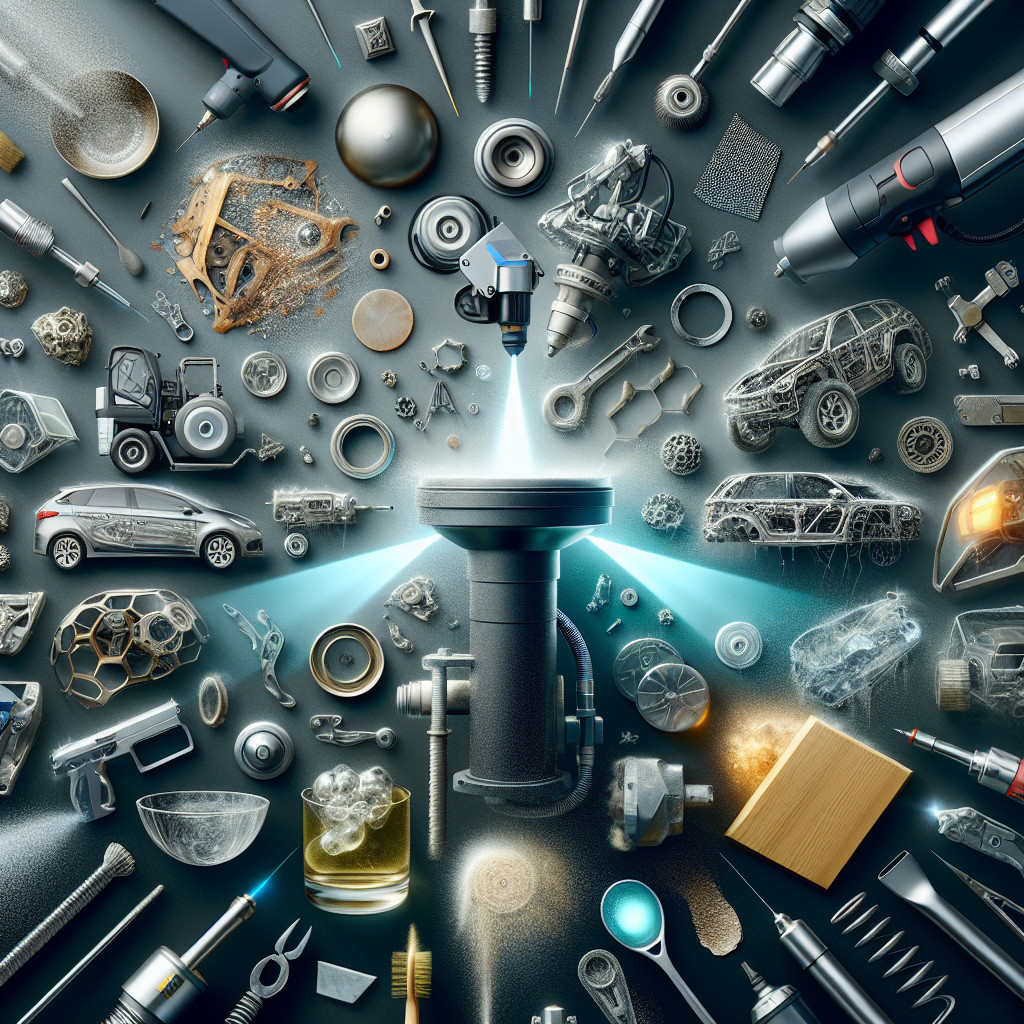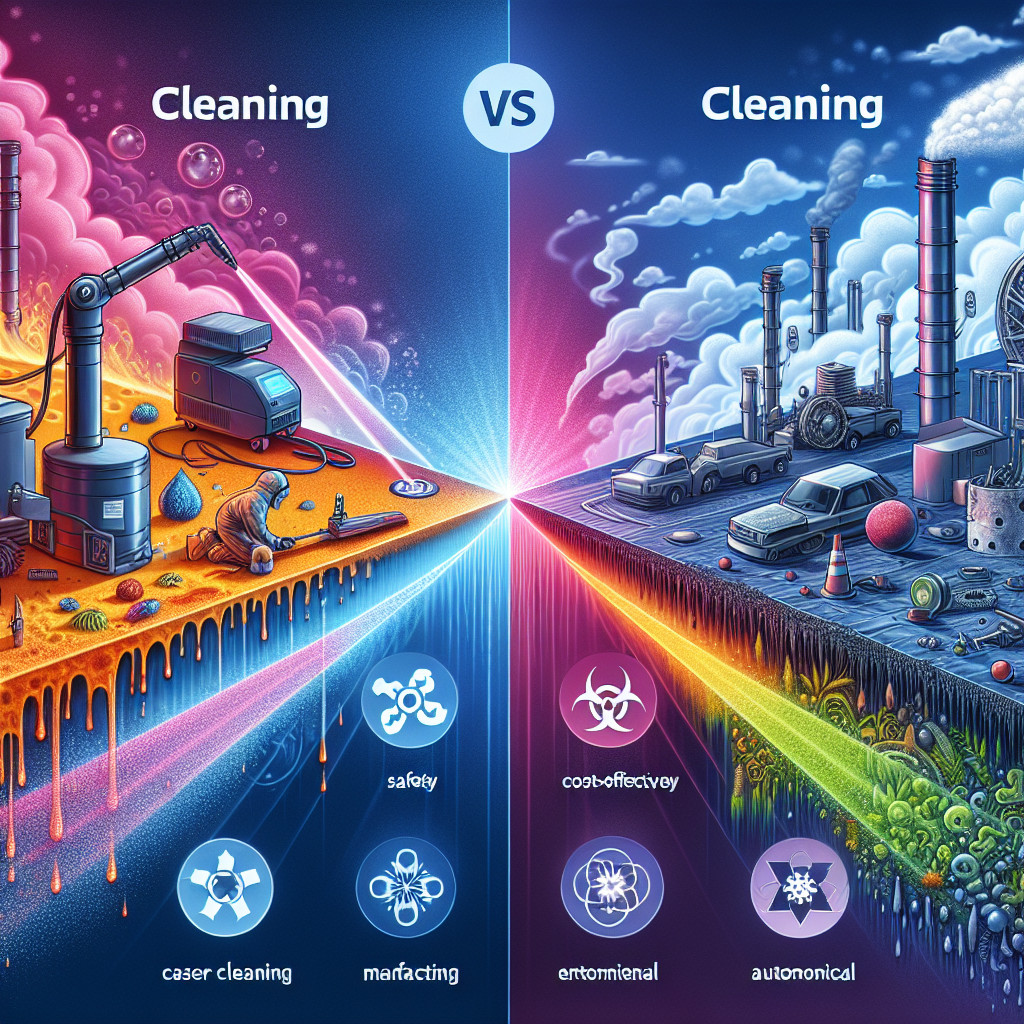- How to evaluate the reputation of a laser cleaning service provider
- The cost-effectiveness of laser cleaning compared to traditional cleaning methods
- The role of laser cleaning in improving product quality and performance
- The advantages of laser cleaning for delicate and sensitive materials
- The role of laser cleaning in the aerospace industry
- The impact of laser cleaning on improving product lifespan and durability
- The advantages of laser cleaning for the oil and gas industry
- The impact of laser cleaning on reducing contamination in cleanroom environments
How to evaluate the reputation of a laser cleaning service provider
1. Research and Gather Information: Start by conducting thorough research on different laser cleaning service providers. Look for their websites, online reviews, and testimonials from previous clients. Pay attention to both positive and negative feedback to get a comprehensive understanding of their reputation.
2. Check for Certifications and Accreditations: A reputable laser cleaning service provider should have the necessary certifications and accreditations. These certifications ensure that the provider follows industry standards and practices. Look for certifications such as ISO 9001, ISO 14001, or any other relevant certifications specific to laser cleaning.
3. Evaluate Experience and Expertise: Consider the experience and expertise of the laser cleaning service provider. Look for how long they have been in the industry and the types of projects they have successfully completed. A provider with extensive experience is more likely to deliver high-quality results.
4. Assess the Technology and Equipment: Laser cleaning technology is constantly evolving, and it is essential to choose a provider that utilizes the latest equipment and technology. Evaluate the provider’s equipment to ensure they have state-of-the-art laser cleaning systems that can effectively meet your requirements.
5. Request References: Ask the laser cleaning service provider for references from their previous clients. Contact these references to inquire about their experience with the provider. This will give you firsthand insights into the provider’s reputation, professionalism, and the quality of their work.
6. Consider Customer Service: A reputable laser cleaning service provider should prioritize excellent customer service. Evaluate their responsiveness, communication skills, and willingness to address any concerns or queries you may have. A provider that values customer satisfaction is more likely to deliver a positive experience.
7. Compare Pricing: While pricing should not be the sole determining factor, it is essential to compare the pricing of different laser cleaning service providers. Be cautious of providers offering significantly lower prices, as this may indicate a compromise in quality. Look for a provider that offers competitive pricing while maintaining high standards.
8. Seek Recommendations: Reach out to industry professionals, colleagues, or friends who have previously used laser cleaning services. Their recommendations can provide valuable insights and help you narrow down your options.
9. Trust Your Gut Feeling: After conducting thorough research and evaluating all the factors mentioned above, trust your gut feeling. If something feels off or if you have any doubts about a particular provider, it is better to explore other options.
In conclusion, evaluating the reputation of a laser cleaning service provider requires thorough research, considering certifications, assessing experience and expertise, evaluating technology and equipment, requesting references, considering customer service, comparing pricing, seeking recommendations, and trusting your gut feeling. By following these steps, you can confidently choose a reputable laser cleaning service provider that meets your specific needs.
Keywords: laser cleaning service provider, reputation, credibility, reliability, quality of work, research, online reviews, testimonials, certifications, accreditations, experience, expertise, technology, equipment, references, customer service, pricing, recommendations, gut feeling.
Long-tail phrases: , choosing a reputable laser cleaning service provider, factors to consider when evaluating a laser cleaning service provider’s reputation, importance of certifications and accreditations in laser cleaning services, evaluating the experience and expertise of a laser cleaning service provider, assessing the technology and equipment of a laser cleaning service provider, the role of customer service in evaluating a laser cleaning service provider’s reputation, comparing pricing of laser cleaning service providers, seeking recommendations for laser cleaning service providers.
The cost-effectiveness of laser cleaning compared to traditional cleaning methods
Laser cleaning, on the other hand, utilizes the power of laser technology to remove contaminants from surfaces without the need for chemicals or abrasive materials. The laser beam is directed at the surface, and the energy from the laser vaporizes or ablates the contaminants, leaving behind a clean surface. This method is not only more environmentally friendly but also eliminates the risk of damage to the surface being cleaned.
One of the key advantages of laser cleaning is its versatility. It can be used on a wide range of materials, including metals, plastics, ceramics, and even delicate surfaces like artwork or historical artifacts. Traditional cleaning methods often require different techniques or products for different materials, making the process more time-consuming and costly. Laser cleaning simplifies the cleaning process by offering a single method that can be applied to various surfaces.
In terms of cost-effectiveness, laser cleaning proves to be a more economical option in the long run. While the initial investment in laser cleaning equipment may be higher compared to traditional cleaning tools, the savings in terms of labor, materials, and time make it a worthwhile investment. Laser cleaning is a highly efficient process that requires minimal manual labor, reducing the need for a large workforce. Additionally, the absence of chemicals or abrasive materials eliminates the recurring costs associated with purchasing these products.
Furthermore, laser cleaning is a non-contact method, meaning there is no physical contact between the cleaning tool and the surface. This eliminates the risk of wear and tear on the cleaning equipment, resulting in reduced maintenance and replacement costs. Traditional cleaning methods often require regular maintenance or replacement of brushes, pads, or other tools, adding to the overall expenses.
In conclusion, laser cleaning offers numerous advantages over traditional cleaning methods. Its environmental friendliness, versatility, and cost-effectiveness make it a superior choice for various industries and applications. The initial investment in laser cleaning equipment may be higher, but the long-term savings in labor, materials, and maintenance outweigh the initial costs. As technology continues to advance, laser cleaning is likely to become even more efficient and affordable, further solidifying its position as the preferred cleaning method.
Keywords: laser cleaning, traditional cleaning methods, cost-effectiveness, efficiency, environmental friendliness, versatility, labor savings, material savings, maintenance savings.
Long-tail phrases:
1. The advantages of laser cleaning over traditional cleaning methods.
2. Cost savings of laser cleaning compared to traditional cleaning.
3. Environmental benefits of laser cleaning.
4. Versatility of laser cleaning on different surfaces.
5. Labor efficiency of laser cleaning.
6. Maintenance savings with laser cleaning.
The role of laser cleaning in improving product quality and performance
Another advantage of laser cleaning is its versatility. It can be used to clean a variety of materials, including metals, plastics, ceramics, and composites. This makes it an ideal solution for industries such as automotive, aerospace, electronics, and medical devices, where cleanliness is crucial for product performance and reliability.
Laser cleaning also offers significant time and cost savings compared to traditional cleaning methods. It is a highly efficient process that can be automated, reducing the need for manual labor and increasing productivity. Additionally, laser cleaning eliminates the need for chemicals or abrasive materials, reducing waste and environmental impact.
In addition to improving product quality and performance, laser cleaning can also extend the lifespan of equipment and reduce maintenance costs. Contaminants such as rust, paint, or grease can accelerate wear and tear on machinery, leading to costly repairs or replacements. By regularly cleaning surfaces with laser technology, manufacturers can prevent the buildup of contaminants and ensure the longevity of their equipment.
Furthermore, laser cleaning can also improve the adhesion of coatings or adhesives to surfaces. Contaminants on the surface can interfere with the bonding process, leading to poor adhesion and product failure. Laser cleaning removes these contaminants, creating a clean and receptive surface for coatings or adhesives, resulting in stronger bonds and improved product performance.
In conclusion, laser cleaning plays a crucial role in improving product quality and performance in various industries. Its ability to remove contaminants without damaging the underlying material, versatility in cleaning different materials, time and cost savings, and the ability to extend equipment lifespan make it an invaluable tool for manufacturers. By incorporating laser cleaning into their production processes, manufacturers can ensure the cleanliness, reliability, and performance of their products.
Keywords: laser cleaning, product quality, performance, contaminants, surface damage, versatility, time savings, cost savings, equipment lifespan, adhesion, coatings, adhesives.
Long-tail phrases: non-contact method of removing contaminants, non-abrasive cleaning solution, wide range of industries, surface damage prevention, environmental-friendly cleaning process, extended equipment lifespan, improved adhesion of coatings and adhesives.
The advantages of laser cleaning for delicate and sensitive materials
Another advantage of laser cleaning is its versatility. It can be used on a wide range of materials, including metals, ceramics, glass, stone, and even sensitive organic materials. This makes it an ideal choice for cleaning delicate and sensitive objects that require special care. Laser cleaning can effectively remove various types of contaminants, such as dirt, rust, paint, grease, and even biological substances, without leaving any residue behind.
Laser cleaning also offers a high level of precision and control. The intensity and duration of the laser beam can be adjusted to suit the specific cleaning requirements of different materials. This allows for precise removal of contaminants without affecting the underlying surface. Laser cleaning can even be used for selective removal of coatings or layers, making it a valuable tool for restoration projects.
Furthermore, laser cleaning is a safe and environmentally friendly method. It does not involve the use of harsh chemicals or solvents, reducing the risk of exposure to harmful substances. The process is also highly efficient, minimizing waste and reducing the need for additional cleaning steps. Laser cleaning systems are designed to be energy-efficient, consuming less power compared to traditional cleaning methods.
In addition to its cleaning capabilities, laser technology also offers other advantages for delicate and sensitive materials. Laser marking and engraving can be used to create permanent and precise markings on various surfaces without causing any damage. This is particularly useful for labeling or branding delicate products or components. Laser welding and cutting can also be performed with high precision, allowing for intricate and delicate work on sensitive materials.
In conclusion, laser cleaning provides numerous advantages for delicate and sensitive materials. Its non-contact nature, versatility, precision, and safety make it an ideal choice for cleaning and restoring delicate objects. Whether it is preserving historical artifacts, cleaning delicate electronic components, or restoring fragile artworks, laser cleaning offers a reliable and efficient solution. By harnessing the power of laser technology, we can ensure the preservation and longevity of delicate and sensitive materials for future generations.
Keywords: laser cleaning, delicate materials, sensitive materials, non-contact, preservation, versatility, precision, control, safe, environmentally friendly, laser marking, laser engraving, laser welding, laser cutting.
Long-tail phrases: advantages of laser cleaning for delicate materials, benefits of laser cleaning for sensitive materials, laser cleaning for preservation of delicate objects, laser cleaning for fragile artworks, laser cleaning for delicate electronic components.
The role of laser cleaning in the aerospace industry
One of the key advantages of laser cleaning in the aerospace industry is its precision. Laser beams can be precisely controlled to target specific areas, allowing for selective cleaning. This is particularly important when dealing with sensitive components such as turbine blades, where even the slightest damage can have catastrophic consequences. Laser cleaning ensures that only the contaminants are removed, leaving the underlying material intact.
Another advantage of laser cleaning is its efficiency. Traditional cleaning methods often involve the use of chemicals or abrasive materials, which can be time-consuming and labor-intensive. Laser cleaning, on the other hand, is a fast and automated process that requires minimal human intervention. It can clean large areas in a short amount of time, reducing downtime and increasing productivity.
Furthermore, laser cleaning is a safe and environmentally friendly option. Traditional cleaning methods often involve the use of hazardous chemicals that can pose health risks to workers and have a negative impact on the environment. Laser cleaning eliminates the need for these chemicals, making it a safer and more sustainable cleaning solution. Additionally, laser cleaning produces no waste or by-products, further reducing its environmental footprint.
In the aerospace industry, where strict quality standards and regulations are in place, laser cleaning offers a reliable and consistent cleaning solution. It ensures that components meet the required cleanliness levels, preventing any potential issues that could compromise the performance or safety of the aircraft. Laser cleaning also helps extend the lifespan of components by removing contaminants that can cause corrosion or wear.
The applications of laser cleaning in the aerospace industry are vast. It can be used to clean a wide range of components, including engine parts, landing gear, fuel nozzles, and even the aircraft’s exterior surfaces. Laser cleaning can remove various contaminants, such as grease, oil, paint, rust, and even biological substances. Its versatility makes it an invaluable tool in maintaining the integrity and performance of aerospace components.
In conclusion, laser cleaning plays a crucial role in the aerospace industry. Its precision, efficiency, safety, and environmental friendliness make it a preferred cleaning method for delicate and complex components. Laser cleaning ensures that aerospace components meet the required cleanliness standards, enhancing their performance and safety. With its wide range of applications, laser cleaning has become an indispensable technology in the aerospace industry.
Keywords: laser cleaning, aerospace industry, precision, efficiency, safety, environmental friendliness, contaminants, components, quality standards, regulations, performance, lifespan, applications.
Long-tail phrases: non-contact cleaning method, environmentally friendly cleaning process, selective cleaning of delicate components, fast and automated cleaning, safe and sustainable solution, compliance with quality standards, prevention of corrosion and wear, versatile cleaning applications.
The impact of laser cleaning on improving product lifespan and durability
One of the key benefits of laser cleaning is its ability to remove contaminants without damaging the underlying material. Traditional cleaning methods, such as sandblasting or chemical cleaning, can often cause surface damage or corrosion. Laser cleaning, on the other hand, is a gentle and precise process that can effectively remove contaminants without affecting the integrity of the material. This is particularly important for delicate or sensitive objects, such as historical artifacts or electronic components.
By removing contaminants from the surface of a product, laser cleaning can improve its overall lifespan and durability. Contaminants, such as dirt or rust, can weaken the material and make it more susceptible to wear and tear. By removing these contaminants, laser cleaning can restore the material to its original condition and strengthen its structure. This can significantly extend the lifespan of the product and reduce the need for frequent repairs or replacements.
Furthermore, laser cleaning can also improve the performance of a product. Contaminants on the surface of an object can interfere with its functionality or efficiency. For example, a dirty lens can affect the clarity of an optical device, or a clogged nozzle can reduce the efficiency of a fuel injector. By removing these contaminants, laser cleaning can restore the optimal performance of the product and enhance its functionality.
In addition to improving product lifespan and durability, laser cleaning also offers several other advantages. Firstly, it is a highly efficient process that can save time and resources. Traditional cleaning methods often require extensive preparation, such as disassembling the object or using harsh chemicals. Laser cleaning, on the other hand, can be performed quickly and easily, without the need for any additional steps. This can significantly reduce the cleaning time and increase productivity.
Secondly, laser cleaning is a versatile technology that can be applied to a wide range of materials and objects. It can be used to clean metals, ceramics, glass, plastics, and even delicate materials, such as fabrics or paper. This makes it a valuable tool in various industries, including manufacturing, automotive, aerospace, and conservation.
In conclusion, laser cleaning has a significant impact on improving product lifespan and durability. By removing contaminants from the surface of an object, laser cleaning can restore its original condition, strengthen its structure, and enhance its performance. This can significantly extend the lifespan of the product and reduce the need for frequent repairs or replacements. Furthermore, laser cleaning is a safe, efficient, and versatile technology that can be applied to a wide range of materials and objects. It is a valuable tool in various industries and has the potential to revolutionize the way we clean and maintain our products.
Keywords: laser cleaning, product lifespan, durability, contaminants, surface damage, corrosion, gentle process, historical artifacts, electronic components, wear and tear, performance, efficiency, time-saving, versatile technology, manufacturing, automotive, aerospace, conservation.
Long-tail phrases:
– The impact of laser cleaning on improving product lifespan
– The role of laser cleaning in enhancing product durability
– How laser cleaning can extend the lifespan of products
– The benefits of laser cleaning for product maintenance
– Laser cleaning as a solution for improving product performance
– The efficiency of laser cleaning in removing contaminants
– Laser cleaning: a safe and environmentally friendly option
– The versatility of laser cleaning in various industries
– Laser cleaning: a revolutionary technology for product maintenance
– The future of laser cleaning in improving product durability.
The advantages of laser cleaning for the oil and gas industry
In recent years, laser cleaning has emerged as a promising alternative for the oil and gas industry. Laser cleaning is a non-contact, non-abrasive method that uses high-intensity laser beams to remove contaminants from surfaces. It works by vaporizing the contaminants, leaving behind a clean surface without causing any damage.
One of the major advantages of laser cleaning is its efficiency. It can remove a wide range of contaminants, including rust, paint, grease, and scale, in a fraction of the time compared to traditional methods. This not only saves time but also reduces downtime for equipment and infrastructure, leading to increased productivity and cost savings.
Another advantage of laser cleaning is its precision. The laser beam can be precisely controlled to target specific areas, allowing for selective cleaning. This is particularly beneficial in the oil and gas industry, where precision cleaning is often required in complex equipment and hard-to-reach areas. Laser cleaning can effectively remove contaminants from intricate parts, such as valves, pipes, and heat exchangers, without causing any damage.
Furthermore, laser cleaning is an environmentally friendly method. Unlike abrasive methods, it does not generate any hazardous waste or release harmful chemicals into the environment. The process is dry and does not require the use of water or chemicals, reducing the consumption of resources and minimizing the impact on the environment.
Laser cleaning also offers long-term cost savings for the oil and gas industry. While the initial investment in laser cleaning equipment may be higher compared to traditional methods, the overall cost of operation and maintenance is significantly lower. Laser cleaning is a non-contact method, which means there is no wear and tear on the equipment, reducing the need for frequent repairs or replacements. Additionally, the efficiency and precision of laser cleaning result in reduced labor costs and increased equipment lifespan.
In conclusion, laser cleaning offers numerous advantages for the oil and gas industry. It is a fast, precise, and environmentally friendly method that can effectively remove contaminants from surfaces without causing any damage. The efficiency and cost savings associated with laser cleaning make it an attractive option for the industry. By adopting laser cleaning technology, the oil and gas industry can improve productivity, reduce downtime, and contribute to a cleaner and more sustainable future.
Keywords: laser cleaning, oil and gas industry, advantages, efficiency, precision, environmentally friendly, cost savings, productivity, downtime, sustainable.
Long-tail phrases: non-contact cleaning method, removal of rust and paint, selective cleaning in complex equipment, environmentally friendly cleaning, cost-effective cleaning solution.
The impact of laser cleaning on reducing contamination in cleanroom environments
One of the main advantages of laser cleaning is its ability to remove contaminants without leaving any residue behind. Traditional cleaning methods, such as wiping or vacuuming, can sometimes spread contaminants or leave behind particles or fibers. Laser cleaning eliminates this risk by directly vaporizing the contaminants, leaving the surface clean and residue-free. This is particularly important in cleanroom environments, where even the smallest traces of contamination can have significant consequences.
Another advantage of laser cleaning is its ability to reach areas that are difficult to access with traditional cleaning methods. Cleanrooms often have complex equipment and structures with intricate geometries, making it challenging to clean every surface thoroughly. Laser cleaning can overcome this limitation by delivering laser energy precisely to the desired location, regardless of its shape or accessibility. This ensures that all surfaces, including those in hard-to-reach areas, are effectively cleaned and free from contamination.
In addition to its cleaning capabilities, laser cleaning also offers other benefits in cleanroom environments. For example, it is a dry cleaning method that does not require the use of water or chemicals. This eliminates the risk of introducing additional contaminants into the cleanroom and reduces the need for hazardous cleaning agents. Laser cleaning is also a non-destructive process that does not damage the underlying material, preserving the integrity and functionality of the cleaned surfaces. Furthermore, laser cleaning is a fast and efficient method that can significantly reduce cleaning time and increase productivity in cleanroom operations.
is significant. By effectively removing contaminants without leaving any residue behind, laser cleaning helps maintain the cleanliness and integrity of cleanroom surfaces. This, in turn, reduces the risk of product defects, improves product quality, and enhances overall cleanroom performance. Laser cleaning also contributes to cost savings by minimizing the need for manual cleaning, reducing downtime, and extending the lifespan of cleanroom equipment.
In conclusion, laser cleaning is a highly effective technology for reducing contamination in cleanroom environments. Its ability to remove contaminants without leaving any residue, reach difficult-to-access areas, and offer other benefits such as dry cleaning and non-destructiveness makes it an ideal cleaning method for cleanroom applications. The impact of laser cleaning on cleanroom performance, product quality, and cost savings cannot be overstated. As cleanroom standards continue to evolve and become more stringent, laser cleaning will undoubtedly play a crucial role in maintaining the cleanliness and integrity of these critical environments.
Keywords: laser cleaning, contamination, cleanroom environments, cleanrooms, particles, microorganisms, chemical residues, traditional cleaning methods, wiping, vacuuming, non-contact cleaning, non-abrasive cleaning, laser energy, vaporization, sublimation, residue-free cleaning, difficult-to-access areas, dry cleaning, non-destructive cleaning, cost savings, cleanroom performance, product quality, cleanroom standards.
Long-tail phrases:
– Laser cleaning as a non-contact, non-abrasive cleaning method
– Advantages of laser cleaning in cleanroom environments
– Laser cleaning for removing contaminants without leaving residue
– Laser cleaning for reaching difficult-to-access areas in cleanrooms
– Laser cleaning as a dry and non-destructive cleaning method
– The impact of laser cleaning on cleanroom performance and product quality
– Cost savings through laser cleaning in cleanroom operations.
- Laser cleaning and long-term cost savings – cost analysis - February 29, 2024
- Laser cleaning and reducing emissions of harmful substances - February 28, 2024
- Can laser cleaning be used in veterinary medicine? - February 28, 2024


























